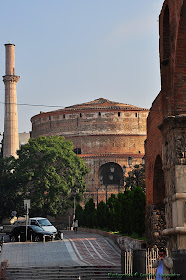There
are many old monuments, ancient Greek, Roman and Byzantine for anyone
to see as he is walking along Egnatia Street at Thessaloniki. More
are being unearthed still.
The
bust shown above, is that of Gaius Galerius Valerius Maximianus
Agustus.
That
was his full name and title, known as Galerius for short. He was a
Roman emperor from 305 to 311 A.D. During his reign he made
expeditions to the east and fought successfully against the Persians
and other enemies of the Roman Empire. He made Thessaloniki the
capital of his part of the Roman Empire and built quite a few
monuments, some of which are still standing not in a bad state. The
Arch shown below, near the western end of Egnatia Street, is know as
the arch of Galerius, and on it there are sculptures of his
expeditions and battles. The round building behind the Arch is known
as Rotonda because of its shape. It was initially built as a
Mausoleum for Galerius, later it became a Christian Church. It is
still standing in a very good shape, and it has been declared by
UNESCO a Wold Cultural Heritage Monument.
The
last five photographs of this post are from the ruins of Galerius's
palace in Thessaloniki.
Ο Γάιος Γαλέριος Βαλεριος Μαξιμιανός Αύγουστος, Γαλέριος εν συντομία ήταν Ρωμαίος αυτοκράτορας από το 305 μέχρι το 311 μ.Χ.
Επεχείρησε, κατά την διάρκεια της εξουσίας του αρκετές επιτυχείς εκστρατείες εναντίον των εχθρών της αυτοκρατορίας, κυρίως εναντίον των Περσών τους οποίους και ενίκησε.
Επίσης ανεκύρηξε την Θεσσαλονίκη πρωτεύουσα του τμήματος της αυτοκρατορίας που διαφέντευε.
Άφησε όπως ήταν επόμενο και αρκετά μνημεία στην Θεσσαλονίκη, όπως την γνωστή Καμάρα ή Αψίδα του Γαλερίου, κοντά στο ανατολικό άκρο της Εγνατίας, με γλυπτές παραστάσεις που απεικονίζουν τις μάχες του, ενώ πίσω από την Καμάρα διακρίνεται η Ροτόντα, ένα πανέμορφο στρογγυλό κτίριο με θαυμάσια ακουστική, που αρχικά προοριζόταν για μαυσωλείο του Γαλέριου, μετά έγινε χριστιανικός ναός και τώρα είναι ανακυρηγμένο μνημείο της Παγκόσμιας Πολιτιστικής Κληρονομιάς της UNESCO.
Λίγο πιο κάτω, σώζονται τα ερείπια από το παλάτι του Γαλέριου και φαίνονται στις τελευταίες πέντε φωτογραφίες.









Such amazing ruins and history! Great captures!! Thanks as always for sharing these with us, Costas! Hope you're enjoying your weekend!
ReplyDeleteSylvia
Thanks for the tour. I love ruins like this. The mosaic with the heart-shaped leaves is unusual. What location is the photo in your header? It's outstanding.
ReplyDeleteTerrific shots of the ruins. So very interesting. Thank you.
ReplyDeleteso interesting or odd to see the ruins mixed in with the city built around it.
ReplyDeletewonderful ethno!
ReplyDeleteLove it!
have a great Sunday!
xoxo, Juliana | PJ’ Happies :) | PJ’ Ecoproject
How wonderful that these ancient arches and buildings are preserved. In the USA they would have been leveled to make room for parking garages.
ReplyDeleteΘαυμάσιες φωτογραφίες από τα αρχαία αριστουργήματα του Γαλέριου.
ReplyDeleteΕίναι πολύ πρωτότυπο να βρίσκονται ανάμεσα σε σύγχρονες πολυκατοικίες!